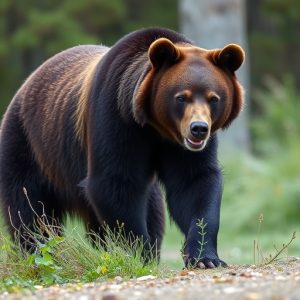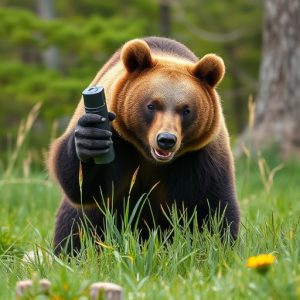Mastering Alaska’s Bear Spray Defense: Water, Safety & Fogger Choice
Bear spray, a vital defense tool against aggressive bears in Alaska's wild landscapes, faces ch…….
Bear spray, a vital defense tool against aggressive bears in Alaska's wild landscapes, faces challenges from high moisture levels and runoff. Effective use requires understanding the chemical composition and application method, especially in humid environments or near water. Proper design features in bear spray foggers, like waterproof durability, are crucial to maintain performance under wet conditions. Responsible usage, including aiming away from water sources and maintaining distance, is essential to preserve both wildlife safety and Alaska's unique ecosystem. Informed users can enhance their outdoor experiences while minimizing environmental impact.
In the rugged landscapes of Alaska, bearing the brunt of wild encounters is a reality. Among these, bear interactions pose significant risks. This article delves into the crucial aspect of bear spray foggers as a defense mechanism. We explore cutting-edge technology, focusing on how water enhances its effectiveness. Moreover, we discuss safe management practices for runoff, ensuring environmental and personal water safety. By understanding these key elements, Alaskans and visitors alike can prepare for potential bear encounters with confidence, choosing the right equipment tailored to the region’s unique conditions.
- Understanding Bear Spray Fogger Technology
- The Role of Water in Bear Spray Effectiveness
- Ensuring Safe Bear Spray Runoff Management
- Best Practices for Bear Encounter Preparation
- Choosing the Right Bear Spray Fogger for Alaska's Unique Conditions
Understanding Bear Spray Fogger Technology
Bear spray foggers are a popular and effective personal defense tool for those venturing into bear country. This technology utilizes a special type of aerosol that, when sprayed, creates a cloud of capsaicin-laced mist designed to deter aggressive bears. The key to its success lies in the chemical composition and application method. Bear spray is formulated with capsaicin, the active ingredient found in chili peppers, which irritates a bear’s eyes, nose, and throat, causing it to retreat.
One crucial aspect of bear spray fogger technology is managing runoff water safety. Since bear spray is highly sensitive to moisture, it can be affected by rain or snow. Proper design includes features that minimize water ingress, ensuring the spray remains effective in various weather conditions. This is essential for users’ safety, as a compromised spray could fail to deter an attacking bear. Therefore, understanding how these devices work and their technological advancements is vital when considering them as a bear defense mechanism during outdoor activities in Alaska or other bear-inhabited regions.
The Role of Water in Bear Spray Effectiveness
In the wild, water plays a significant role in the effectiveness of bear spray, a crucial defense mechanism for hikers and outdoor enthusiasts navigating Alaska’s rugged terrain. Bear spray is designed to create a barrier between the user and the bearing, using capsaicin, the active ingredient found in chili peppers. When deployed, the spray forms a fog that can reach distances up to 30 feet, creating a safe zone. Water, however, can significantly impact this safety measure. High water content in the air can reduce the concentration of bear spray particles, lessening their effectiveness. This is particularly relevant in humid environments or when spraying near bodies of water, as the water vaporizes and dilutes the spray’s potency.
Understanding how water affects bear spray performance is vital for ensuring water safety during outdoor activities. Users must be aware that wet conditions may require them to use more bear spray to achieve the desired level of protection. Proper application techniques, such as spraying towards the bear’s face and eyes, can enhance the spray’s effectiveness in humid or watery environments. This knowledge empowers individuals to make informed decisions while hiking or camping in areas known for bear encounters, thereby ensuring their safety and peace of mind.
Ensuring Safe Bear Spray Runoff Management
Proper management of bear spray runoff is a critical component of ensuring water safety in Alaska’s unique ecosystem. When used correctly, bear spray can be an effective deterrent against aggressive bears, but improper disposal or runoff can contaminate nearby water sources. It’s essential to understand that bear spray is not biodegradable and can remain potent for extended periods, posing risks to both wildlife and humans.
To mitigate these dangers, individuals using bear spray should take precautions to prevent runoff from entering streams, lakes, or rivers. This includes aiming spray away from bodies of water and ensuring adequate distance. Additionally, using specialized foggers designed for reduced runoff can help minimize environmental impact. Remember, responsible usage and proper disposal practices are key to maintaining a safe and sustainable environment in Alaska’s bear country.
Best Practices for Bear Encounter Preparation
When preparing for a potential bear encounter in Alaska, having the right equipment is just the first step. Bear spray fogger defense should be used as a last resort, and proper application technique is crucial. Always carry your bear spray in an easily accessible location, and ensure it’s fully charged before heading out into the wilderness. Remember, bear spray runoff water safety is essential; keep your spray dry until needed to avoid accidental activation or reduced effectiveness.
Before venturing into bear country, educate yourself about bear behavior and local regulations. Know the recommended distances for encounter safety, and practice making loud noises while hiking to deter bears naturally. Regularly updating your knowledge on bear encounter preparation can significantly enhance your safety and enjoyment during outdoor activities in Alaska’s beautiful but unpredictable environment.
Choosing the Right Bear Spray Fogger for Alaska's Unique Conditions
When selecting a bear spray fogger for Alaska’s rugged terrain, it’s vital to consider factors that ensure its effectiveness in both extreme cold and damp conditions. Not all bear sprays are created equal; some are designed for optimal performance in dry environments, while others cater to wetter climates like Alaska’s. Look for products specifically formulated for cold-weather use, as these will have better aeration mechanisms to combat runoff water, ensuring the spray reaches its intended target.
Bear spray runoff water safety is a unique challenge in Alaska due to the high moisture levels. Choose a fogger with a durable, waterproof design and a powerful enough nozzle to project the spray several feet, accounting for the damp environment. Additionally, consider brands that offer longer-lasting canisters or refill options, allowing you to stay prepared during extended outdoor adventures in this vibrant yet potentially dangerous landscape.
When navigating Alaska’s wilderness, understanding bear spray fogger technology and its interaction with water is paramount for your safety. Proper runoff management ensures that you’re not inadvertently leaving behind a potent repellent that could impact the environment or pose risks to others. By following best practices for preparation and choosing the right equipment suited to Alaska’s unique conditions, you’ll be well-equipped to handle potential bear encounters while prioritizing water safety. Remember, knowledge and the right tools can make all the difference in ensuring a safe and enjoyable outdoor experience.


